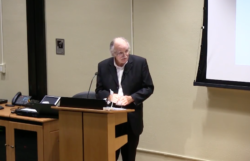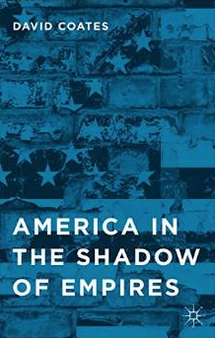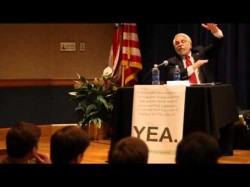Reflections on the Obama Presidency: (2) The politics of gridlock
(The second of a series of four reflections observing the Obama presidency in real time; for the first, see ‘The gap between promise and performance’i)
It was never going to be easy to govern America in a progressive fashion, given the scale of the economic crisis left in place by the Bush Administration and the destabilized nature of the Middle East in the wake of the Iraq War. The legacy of the Bush Administration was always going to make life difficult for whoever followed them into power; but then, there is nothing particularly unusual in that. The legacy of Republican misrule is something that Democratic presidents often inherit. They often find that the political compass shifts in their direction only when more conservative political actors have failed so badly as to discredit themselves, in the process giving progressive politicians access to power and the opportunity to act. Which is why Democrats always need a politics that can respond to and capitalize upon inherited difficulties, a politics that can strengthen the hold of the party on power by successfully addressing things that Republicans had failed to do. They certainly needed such a politics in 2008; and for a moment, indeed, it did look as though they possessed one. The Obama Administration began 2009 in a confident, even a hegemonic fashion, with Republican self-confidence low and unregulated capitalism in visible freefall: but after 2010 that pattern of confidence, capacity and free-fall incrementally reversed itself. A Democratic progressive hegemony was not sustained – to our immense long-term cost – and instead political gridlock replaced social reform.
There are at least three reasons for this change in fortunes. Two of the three cannot be laid at Barack Obama’s own door. They are more our fault than they are his; but the third is not. That is Obama’s alone: and we need to deal with all three (two here, and one in the posting to follow)
The failure to elect a governing coalition
In retrospect, presidencies always look as though they were inevitable, but of course that is rarely if ever the case. It was certainly not the case for Barack Obama. On the contrary, there is a very real sense in which Barack Obama arrived at the White House as a relatively unknown phenomenon – as a president who was only accidentally in power, and one who was there primarily because of two sets of things for neither of which he bore any direct responsibility. Obama reached the White House in part only because of a growing revulsion, in wide swathes of the American electorate, with the policies and performance of the second Bush Administration. He reached there too in part because of the severity of the financial crisis which serendipitously occurred on Bush’s watch. The election result in 2008 was, in that sense, as much (or even more) a negative vote against Bush than it was a positive one for Obama. Moreover, though he found himself facing a Congress that was also in Democratic hands, that control was itself not something he and his team had created. Rather, he and his incoming Cabinet were the accidental beneficiaries of the way in which the Democrats had consolidated their hold on power in Washington by putting into particularly vulnerable House seats very conservative Democrats – candidates who had effectively canvassed as blue-dog Democrats while exploiting the growing alienation of moderate Republicans from the Bush presidency. The result was a temporary coming together in 2009 of an early Obama presidency and a Congressional majority for Democrats – the electoral base of both built on anti-Bush soil – a temporary majority that would be washed away very quickly once the revolt against Bush had been replaced by the presence in the White House of a Democrat, and a black Democrat at that.
This erosion of the Democrats’ governing majority during the first term of the Obama presidency had two moments, not just one. When that majority held – which it did until the 2010 mid-terms – Obama as president still found that it required an enormous amount of political compromise within Democratic ranks to effect even modest legislative reform. Wall Street reform was only achieved – via the Dodd-Frank Act – only after the more draconian of its oversight proposals had been significantly diluted. In the case of the Affordable Care Act, the damage inflicted on the original proposals ran deeper still, with the Act seriously weakened by the absence of a public option which could not be created because of opposition from blue-dog Democrats as well as from the remaining Republicans. The public spectacle of this bitter and prolonged internal party wrangling then impacted directly the House elections of 2010. For by then, both the passage of time and the revival of confident Republican rhetoric had combined to muddy the public perception of the causes of the financial crisis; and the recessionary effects of that crisis continued to be lived on a daily-basis by key sections of that electorate – only now recessionary effects that were lived and experienced as a stress point on Obama’s watch rather than on that of George W. Bush. An electorate willing to vote into Congress blue-dog Democrats in 2008 switched back in significant numbers in 2010 to voting for even more conservative Republicans – giving the Administration what Obama called at the time a “shellacking” – and in the process effectively blocked the ability of the Administration to continue its reform program. That blockage was obvious long before the end of Obama’s first term, and was very clear by its end.
The lesson to be drawn from this is also clear. It is that just as the Republicans have a solid governing majority whenever they take both houses of the Congress because they are united around a common agenda for which they can legitimately claim a popular mandate, so too must the Democrats. Indeed, it is vital that the Democratic Party follow the Republican lead here: organizing themselves internally to unite the House, the Senate and the White House around an equally coherent and more progressive agenda. Because whenever the Democratic coalition fails to do this, the best that they end up with is a Democrat in the White House (because of the demographic advantage that the Party normally enjoys in any country-wide contest; because, that is, of the country-wide growth of minority populations that the Democrats have long serviced better than Republicans) only then to face a House (elected from narrower and now heavily gerrymandered constituencies) and even a Senate that is in the full control of the other party. And that other party had absolutely nothing to gain, and everything to lose, from collaborating in any way with a progressive White House. Republicans have no interest in seeing the political class in Washington DC collaborate on domestic policy reform. On the contrary, the Republican Party leadership know that ultimately it is they and their anti-federal reform programs, and not their Democratic Party opponents, who ultimately benefit from gridlock in Washington – not least because the daily experience of that gridlock makes it ever more difficult for Democrats to pitch the case for the use of big government as a vehicle of progressive change.
The failure to defeat Republican intransigence
Which brings us to the Republicans, who are – from any kind of progressive viewpoint – currently in a particularly uncooperative frame of mind. For all the scale of his victory on November 8th, it is still clear that supporting Donald Trump was a stretch for many mainstream Republicans, something they did largely for anti-Clinton reasons rather than pro-Trump ones. Yet for all the internal party feuding that was such a feature of the last months of the Republican presidential campaign in 2016, the fact that Donald Trump was the nominee that Republicans chose to fight over – the fact that he was chosen at all – tells us that though the Republican Party is still a broad church, it is not as broad now as once it used to be. We would all do well to understand Donald Trump’s selection as the Party’s nominee, therefore, as reflective of changes deep in the base of the Republican Party – changes that in the last decade have drained the party of any tolerance for (or membership by) liberal/centrist Republican Party activists. With them gone, the base of the Party is now significantly more conservative than even the bulk of Republicans in the Washington political class, and even less willing than those Washington legislators to compromise with their more progressive alternatives. The problem the Democrats have, when seeking compromises of that kind, is that via its ever-tightening control of the selection process for Republican legislators through internal party-primaries dominated by Tea Party activists and worse, the conservative base of the Republican Party now calls all the main shots on the political right.
The Republican Party base currently contains at least four overlapping constituencies. It contains social conservatives largely animated by their opposition to same-sex marriage and a woman’s right to choose. It contains a libertarian current that is largely indifferent to abortion and marriage issues (and is often quite liberal on these issues), but highly animated by opposition to increasing government regulation: certainly animated against regulations on gun ownership and use, and sometimes animated even against regulations on environmental protection and conditions of employment at work. It contains a Tea Party base into which some of those social conservative and libertarian elements merge, but which tends to be made up of people “whiter, older, better educated and wealthier than the average American,”ii or as Theda Skocpol and Vanessa Williamson found “Republican, white, male, married and older than 45.”iii That Tea Party wing of the Republican coalition has thus far proved to be more concerned with the standard Republican mixture of fiscal rectitude, low taxation and traditional family values than with either the social agenda or libertarian concerns, while remaining “in general supportive of programs they see as helping Americans like themselves”iv such as Social Security and Medicare. Tea Party ire tends to focus instead on federal spending directed at the idle poor, those here illegally, or any over-indulged youth – more focused and very intense.
What Donald Trump’s campaign then added to that pre-existing Republican mix were people whom Hillary Clinton inadvisably once labeled “the deplorables:” namely angry, frustrated, mainly white, non-college educated low-paid workers and their immediate family members in areas of severe economic deprivation, supplemented in both number and volume by overtly sexist, racist and xenophobic conservatives – a radical right-wing fringe that has long been there in the background of the Republican coalition but who until lately had been largely silenced behind walls of political correctness sustained by Republican Party elites no less than by Democratic Party ones. What held those four groups together during the Obama presidency, given their different social centers of gravity and their differing pivotal agendas, was far more opposition to Barack Obama himself than it was unity around any alternative Republican candidate. Indeed, so lacking in that alternative was the Republican Party during the Obama second term that it took 16 would-be Republican presidential candidates to give initial vent to the various elements within the party coalition. It took so many in fact that the one who eventually slipped through to the nomination was the one freest of dependence on any particular wing of the party. For those of you who know your nineteenth-century French history, the Republicans in 2016 went in search of their Napoleon Bonaparte, and ended up with a modern-day equivalent of Napoleon the Third.
First posted, with full academic citations, at www.davidcoates.net
This is an extract from the closing essay in David Coates, The Progressive Case Stalledv Published by Library Partners Press, and bringing together all the Coates’ postings on Barack Obama’s second term. The postings on the Obama first term are also available, collected together as Pursuing the Progressive Case.vi Together, the two volumes make up Observing Obama in Real Time.
ii Vanessa Williamson, “Tea Party,” in David Coates, Kathy Smith and will Waldorf (editors), The Oxford Companion to American Politics. New York: Oxford University Press, 2013, Volume 2, p. 345
iii Theda Skocpol and Vanessa Williamson, The Tea Party and the Remaking of Republican Conservatism. New York: Oxford University Press, 2012, p. 23.
iv Williamson, op. cit., p. 346
v Available at https://www.amazon.com/Progressive-Case-Stalled-Observing-Obama-ebook/dp/B01MYOWUSO/ref=sr_1_1?s=books&ie=UTF8&qid=1480953310&sr=1-1
vi Available at https://www.amazon.com/Pursuing-Progressive-Case-Observing-Obama-ebook/dp/B01N77BP87/ref=sr_1_1?s=books&ie=UTF8&qid=1480953147&sr=1-1&keywords=Pursuing+the+progressive+case
Tags: Barack Obama, blue-dog Democrats, Donald Trump, financial crisis, George W. Bush, Republican intransigence, Tea Party, white working class anger
David Coates holds the Worrell Chair in Anglo-American Studies at Wake Forest University. He is the author of Answering Back: Liberal Responses to Conservative Arguments, New York: Continuum Books, 2010.
He writes here in a personal capacity.





